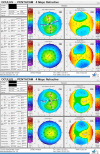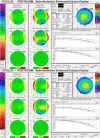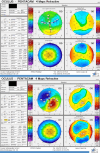Unilateral Corneal Ectasia After Bilateral Transepithelial Photorefractive Keratectomy
- PMID: 39840211
- PMCID: PMC11749241
- DOI: 10.7759/cureus.76189
Unilateral Corneal Ectasia After Bilateral Transepithelial Photorefractive Keratectomy
Abstract
We present the case of a 23-year-old male who experienced vision loss in his left eye 15 months after undergoing bilateral transepithelial photorefractive keratectomy (T-PRK). Despite the absence of any significant preoperative topographical risk factors in either eye, corneal ectasia was later confirmed in the left eye, while the right eye remained normal. Subtle asymmetry in topometric indices and a borderline high Index of vertical asymmetry (IVA) reading suggested the possibility of early subclinical keratoconus, potentially increasing the risk of post-refractive ectasia. The patient received corneal cross-linking (CXL) treatment in the affected eye to halt further progression, while the right eye remained under observation. This report reviews the rare instances of post-refractive ectasia. It highlights the potential role of subtle corneal irregularities in predisposing to ectasia, even without traditional risk factors.
Keywords: cornea; ectasia; laser refractive surgeries; myopia; trans prk.
Copyright © 2024, AlShawabkeh et al.
Conflict of interest statement
Human subjects: Consent for treatment and open access publication was obtained or waived by all participants in this study. Conflicts of interest: In compliance with the ICMJE uniform disclosure form, all authors declare the following: Payment/services info: All authors have declared that no financial support was received from any organization for the submitted work. Financial relationships: All authors have declared that they have no financial relationships at present or within the previous three years with any organizations that might have an interest in the submitted work. Other relationships: All authors have declared that there are no other relationships or activities that could appear to have influenced the submitted work.
Figures



Similar articles
-
Corneal collagen cross-linking for ectasia after LASIK and photorefractive keratectomy: long-term results.Ophthalmology. 2013 Jul;120(7):1354-9. doi: 10.1016/j.ophtha.2012.12.027. Epub 2013 Apr 10. Ophthalmology. 2013. PMID: 23582990
-
Corneal ectasia after photorefractive keratectomy for low myopia.Ophthalmology. 2006 May;113(5):742-6. doi: 10.1016/j.ophtha.2005.11.023. Ophthalmology. 2006. PMID: 16650667
-
Collagen crosslinking for ectasia following PRK performed in excimer laser-assisted keratoplasty for keratoconus.Eur J Ophthalmol. 2012 Mar-Apr;22(2):274-7. doi: 10.5301/ejo.5000019. Eur J Ophthalmol. 2012. PMID: 21786270
-
Combined corneal CXL and photorefractive keratectomy for treatment of keratoconus: a review.Int J Ophthalmol. 2019 Dec 18;12(12):1929-1938. doi: 10.18240/ijo.2019.12.16. eCollection 2019. Int J Ophthalmol. 2019. PMID: 31850179 Free PMC article. Review.
-
Review of Laser Vision Correction (LASIK, PRK and SMILE) with Simultaneous Accelerated Corneal Crosslinking - Long-term Results.Curr Eye Res. 2019 Nov;44(11):1171-1180. doi: 10.1080/02713683.2019.1656749. Epub 2019 Aug 23. Curr Eye Res. 2019. PMID: 31411927 Review.
References
-
- Efficacy and safety of transepithelial photorefractive keratectomy. Adib-Moghaddam S, Soleyman-Jahi S, Sanjari Moghaddam A, et al. J Cataract Refract Surg. 2018;44:1267–1279. - PubMed
-
- Transepithelial photorefractive keratectomy: clinical results. Fadlallah A, Fahed D, Khalil K, et al. J Cataract Refract Surg. 2011;37:1852–1857. - PubMed
-
- Risk factors for postlaser refractive surgery corneal ectasia. Jin SX, Dackowski E, Chuck RS. Curr Opin Ophthalmol. 2020;31:288–292. - PubMed
Publication types
LinkOut - more resources
Full Text Sources
